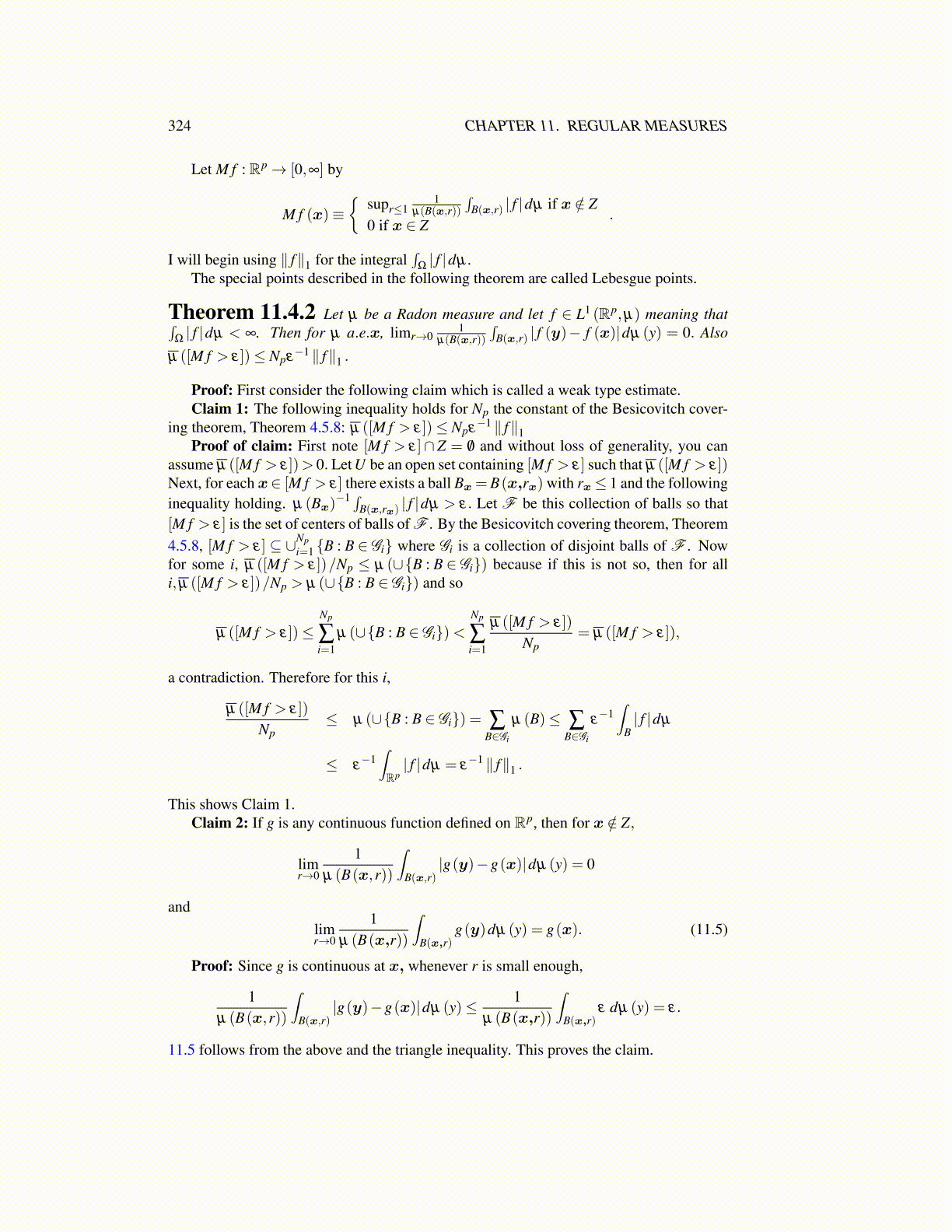
324 CHAPTER 11. REGULAR MEASURES
Let M f : Rp→ [0,∞] by
M f (x)≡{
supr≤11
µ(B(x,r))
∫B(x,r) | f |dµ if x /∈ Z
0 if x ∈ Z.
I will begin using ∥ f∥1 for the integral∫
Ω| f |dµ .
The special points described in the following theorem are called Lebesgue points.
Theorem 11.4.2 Let µ be a Radon measure and let f ∈ L1 (Rp,µ) meaning that∫Ω| f |dµ < ∞. Then for µ a.e.x, limr→0
1µ(B(x,r))
∫B(x,r) | f (y)− f (x)|dµ (y) = 0. Also
µ ([M f > ε])≤ Npε−1 ∥ f∥1 .
Proof: First consider the following claim which is called a weak type estimate.Claim 1: The following inequality holds for Np the constant of the Besicovitch cover-
ing theorem, Theorem 4.5.8: µ ([M f > ε])≤ Npε−1 ∥ f∥1Proof of claim: First note [M f > ε]∩ Z = /0 and without loss of generality, you can
assume µ ([M f > ε])> 0. Let U be an open set containing [M f > ε] such that µ ([M f > ε])Next, for each x∈ [M f > ε] there exists a ball Bx =B(x,rx) with rx≤ 1 and the followinginequality holding. µ (Bx)
−1 ∫B(x,rx) | f |dµ > ε. Let F be this collection of balls so that
[M f > ε] is the set of centers of balls of F . By the Besicovitch covering theorem, Theorem4.5.8, [M f > ε] ⊆ ∪Np
i=1 {B : B ∈ Gi} where Gi is a collection of disjoint balls of F . Nowfor some i, µ ([M f > ε])/Np ≤ µ (∪{B : B ∈ Gi}) because if this is not so, then for alli,µ ([M f > ε])/Np > µ (∪{B : B ∈ Gi}) and so
µ ([M f > ε])≤Np
∑i=1
µ (∪{B : B ∈ Gi})<Np
∑i=1
µ ([M f > ε])
Np= µ ([M f > ε]),
a contradiction. Therefore for this i,
µ ([M f > ε])
Np≤ µ (∪{B : B ∈ Gi}) = ∑
B∈Gi
µ (B)≤ ∑B∈Gi
ε−1∫
B| f |dµ
≤ ε−1∫Rp| f |dµ = ε
−1 ∥ f∥1 .
This shows Claim 1.Claim 2: If g is any continuous function defined on Rp, then for x /∈ Z,
limr→0
1µ (B(x,r))
∫B(x,r)
|g(y)−g(x)|dµ (y) = 0
andlimr→0
1µ (B(x,r))
∫B(x,r)
g(y)dµ (y) = g(x). (11.5)
Proof: Since g is continuous at x, whenever r is small enough,
1µ (B(x,r))
∫B(x,r)
|g(y)−g(x)|dµ (y)≤ 1µ (B(x,r))
∫B(x,r)
ε dµ (y) = ε.
11.5 follows from the above and the triangle inequality. This proves the claim.